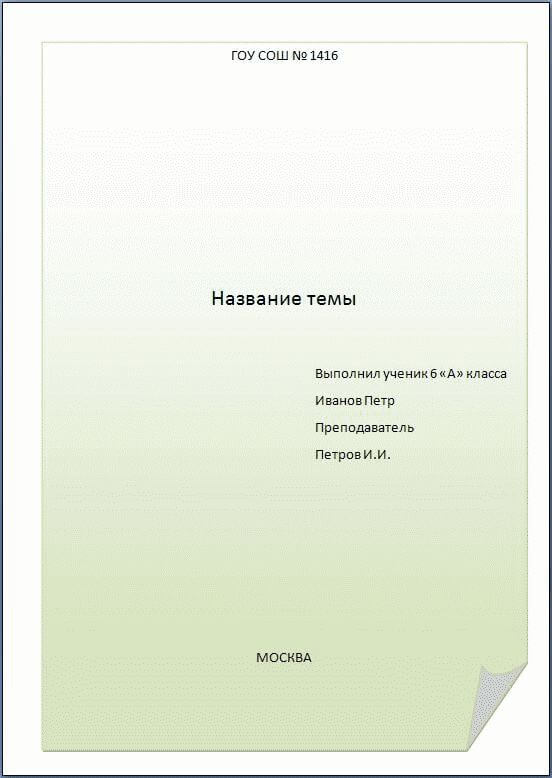REQUIREMENTS FOR FORMING A REPORT (SUMMARY)
Report Structure
Title page contains the following attributes:
at the top title page the name of the institution (without abbreviations) in which the work was performed is placed;
in the middle of the sheet the topic of the work is indicated;
below on the right - information about the author of the work (full name (full name) with an indication of the course, specialty) and supervisor (full name (full name), position);
Conclusion: page titles, design them well!
In many cases, you also don't need to include the brand name in the title. The conclusion of this article may well be: invest a little more time in writing good name pages. Going back and optimizing some of the page titles after publication can also be worth it.
Your instructors expect to receive documents that are properly formatted and laid out. Use the following guidelines when setting paper. It's easiest if you use correct settings from the very beginning; otherwise, you'll have to go back and reformat your paper.
the place and year of performance of the work are indicated at the bottom in the center.
The title page is not numbered, but is counted as the first page.
- One inch on the sides, top and bottom.
- Double-click the document text.
- This good idea include your last name as well if the pages are split.
- Center your name directly below the heading.
- Both use the same formatting rules.
- The note number comes after all other punctuation marks.
- Do not use bold font or big size for the title.
- Do not reuse numbers in your notes!
- Each quote gets a new number.
- Pay attention to the indents.
Table of contents is the second page of the work. Here all the headings of sections of the text are sequentially given and the pages from which these sections begin are indicated. In the content of the table of contents, all the titles of chapters and paragraphs should be given in the same sequence in which the presentation of the content of this text in the work begins without the word “page” / “page”. Chapters are numbered in Roman numerals, paragraphs in Arabic.
Use left-aligned text that will have a torn right edge. Number right from the first text page before last page bibliographies, but don't count pages after the end of the text as part of your page count. Ask your teacher if double-sided printing is okay. The instructor's name, course title and block, and the date should be written on three lines and centered at the bottom. Don't try to make your title page use bold, underline, or creative fonts. Don't put the page number on the cover page and don't count it as part of the total number of pages. For agencies, include an abbreviated expression in parentheses after the full name on first use, e.g. Footnotes go to the bottom of the page where the link occurs; Endnotes go on a separate page after the body of the paper. In the body of the essay: indicate the number of the note at the end of the sentence where the reference occurs, even if the referenced material is mentioned at the beginning of the sentence. Never use two note numbers at the end of a sentence. Be sure to use proper formatting - notes and bibliography styles are different. Use a "hanging indent" - the first line of a quote starts with a margin, subsequent lines are indented. If your source doesn't have an author, alphabetically by title in authors - don't make a separate list. Don't separate primary and secondary sources unless your teacher asks you to. The format of the notes uses the name of the surname, in the bibliography the surname, first name are used. Notes use the first line indent, bibliographies use a hanging indent. Bibliography in alphabetical order provided by the author.
Introduction(the essence of the problem under study is formulated, substantiated topic selection, its significance and relevance are determined, the purpose and objectives of the report are indicated, and the characteristics of the literature under study are given).
Main part(the main material on the topic; can be divided into sections, each of which, demonstratively revealing a separate problem or one of its sides, is logically a continuation of the previous section).
In order not to forget anything, follow Miriam Greiter's explanations extracted from Good to write your dissertation or internship report published in Student's publications. Some of the pages that precede the job description are required, others are optional.
Title page and title page
Cover page - simple empty page located immediately after the cover. For its part, the title page contains the same information as the cover.
Dedications and epigraphs
Devotion is a way of paying respect to someone by symbolically offering them the fruit of one's work. The phrase of dedication the highest degree personal and generally charged with emotions, expresses gratitude to the author for Close relative a person who has made a great contribution to the success of the work or a person who is especially admired.Conclusion(summarizes or gives a generalized conclusion on the topic of the report, offers recommendations, indicates the prospects for researching the problem).
Bibliography. The number of literature sources is at least five. A separate (numbered) source is considered to be both an article in a journal, a collection, and a book. Thus, one collection may be mentioned in the list of references 2-3 times if you used 2-3 articles in your work. different authors from one collection.
Obviously this is not required. Epigraph - short quote, which the author puts at the top of his book to give a foretaste of his ideas and style. Often tacitly declaring high patronage famous person, who is its author, sometimes the epigraph is found at the beginning of a chapter or section, the epigraph is, of course, optional.
Dedications and epigraphs have their own page. Particular attention should be paid to their presentation. They are usually written in italics, located in the upper half of the page and aligned to the right. Courtesy and use means that we thank, preferably on a separate page, the people who have contributed to the success of the work. Thanks have a less emotional tone than dedications. They are no less warm. You can thank the people whose help was especially decisive, and mention others collectively or in separate groups.
Application(tables, charts, graphs, illustrative material, etc.) is an optional part.
Requirements for the format of the text of the report
The report must be completed competently, respecting the culture of presentation.
The scope of work should be no more than 20 pages typewritten text (computer typing) on one side of the format sheet A4, excluding application pages.
Acknowledgments are optional. Their absence, however, is hardly visible: there is a high probability that he is considered a guy. The valuable help received in the course of the work certainly deserves coverage and public approval. Everyone must find a formula that is relevant, original and heartfelt.
We talk about it here, but you don't need it. However, once the document is printed, there are still some errors that may be erroneous, which tells the reader that you have noticed the shells, and that you condemn them. If there are many errors, it is better to print new version work. The list of errors sometimes fits into the obligation, on a page folded in half: then the reader has every chance to mislead.
Text research work printed in Word editor, interval - one and a half, Times New Roman font, size - 14 , orientation - portrait. Indent from the left edge - 3 cm, right - 1.5 cm; upper and lower - 2 cm each; red line - 1 cm; alignment in width.
Off-text links are formatted in square brackets, which indicate serial number the source in the alphabetical list of references located at the end of the work, and the page number is indicated separated by a comma. For example .
Foreword and Introduction
A summary is an abbreviated table of contents: it usually appears at the top of the book, and the table of contents is placed at the end. Dedicated to this file:. The preface, which is optional, is intended to inform the reader of special circumstances or obstacles that may have affected the course of the study, especially when the author exhibits a marked bias, or when he was required to keep certain information.
Requirements for the format of the text of the report
The preface precedes the introduction: its purpose is to inform the reader about the very conditions of reflection, while the introduction is already focused on its content. The introduction covers one or more individual pages. Do you want product sheets to produce articles for web content?
Titles printed in the center in 16th font size. Headings are in bold, subheadings in bold italics; headings and subheadings are separated by one indent from the general text above and below. After the title of the topic, subsection, chapter, paragraph (table, figure), a dot is not put.
Job pages should be numbered; their sequence should correspond to the work plan. Numbering starts from page 2. The number indicating the serial number of the page is placed in the right corner of the bottom margin of the page. Title page not numbered.
So it should make you read and click on the link. In the source code of the page, the title is displayed in the following way. If your title is a bit long, you won't see it in its entirety, especially if your browsers have multiple tabs open.
The title of your page can be the same as the title of the article. The title of the article corresponds to the tag in the page code. The purpose of the snippet and title is to better represent and describe each result and explain how it relates to the user's query. The information given is better, search results snippets could be better. With rich snippets, webmasters with structured data sites can assign a label to their content so that each piece of text represents a particular type of data, such as a restaurant name, address, or vote.
Each part of work(introduction, main part, conclusion) is printed from a new sheet, sections of the main part - as a whole.
Must be in alphabetical order bibliographic apparatus.
Design should not include frills, including: various colors text that is not comprehensible drawings, large and fanciful fonts, etc.
How to write a title page for a report
Find out how rich snippets can improve your site's position in search results. We use a number of other sources for this information, including descriptive information about the title and meta tags of each page. We may also use publicly available information or create rich snippets based on the markup on the page.
We cannot manually edit the titles or snippets of individual sites, but we are working to make them as relevant as possible. You can improve the quality of your page titles and snippets by following the general guidelines below.
Bibliography rules
Book template:
Sakharov Z.K. History manual: Design of scientific work. - M.: Bustard, 2003. - 76 p.
Model 2.
A sample of the design of the material from the collection:
Sakharov Z.K. Educational tasks in the system of distance learning // Sat. scientific papers"On the way to the 12 - summer school" / Ed. Yu.I. Dika, Sakharova Z.K. - M: RAO IOSO, 2000. - S. 209 -213.
Create descriptive page titles
Titles are extremely important as they provide users with quick information about the content of the result and why it applies to the query. Titles are often the primary information users use to determine which results to click on, so it's important to have high quality titles on your web pages.
Below are some tips for managing headers. As explained above, make sure that each page of the site has a title specified in the tag. Avoid vague descriptions such as "Home" to indicate your home page or "Profile" to link to a person's profile. Also avoid unnecessary long or verbose titles that might be truncated when viewing search results. It is sometimes useful to have multiple descriptive terms in a title, but there is no reason why the same words or phrases are repeated multiple times. It is important to have separate and descriptive titles for each page of the site. Cheap selling all pages in a commercial site does not allow users to distinguish the difference between pages and pages. There aren't even long titles that just change for information, for example a standard title like "Watch Videos, Text, Posters, Albums, Reviews and Concerts" has a lot of non-informational text. The solution is a dynamic update. From the title, it is better to reflect the current content of the page: for example, include words,, "texts", etc. Only if this page contains videos or texts. "Another option is to use" as short title and meta descriptions to describe the content of the site. The title of the site's home page is suitable for including some additional information about the site, such as "Sitosocial example", a meeting place, and make friends. However, seeing this text in the header of every page on a site affects its readability and looks particularly repetitive if the same query returns multiple pages on the site. Keyword excess. . If we find that a particular result has one of the problems listed above, we can try to create an improved title from an anchor, text on the page, or other sources.
Model 3.
An example of a magazine article:
Petrova A.G. Modern technologies education // School technologies - 2002. - No. 2. - P. 40-45.
Model 4.
A sample of the data of the dissertation abstract:
Batrak V.I. Increasing the durability of kinematic pairs of transport vehicles: Abstract of the thesis. dis. for the competition scientist step. cand. those. Sciences / Orenburg. state un-t. - Orenburg, 1997. - 13 p.
Notes
The name and patronymic of the author in the initials are indicated after the surname.
The titles of monographs, journals and collections of scientific papers are given without quotation marks.
The place of publication of the book (city) is indicated in full, with the exception of: Moscow (M.), St. Petersburg (St. Petersburg), Rostov-on-Don (Rostov-n / D).
Publisher names are not in quotation marks.
When indicating the year of publication, the letter "g." (year) missing.
When formatting the output data of the source from which the material is extracted, the pages on which it is located are indicated: S. is written - capital with a dot, followed by page numbers. In the variant of the design of an integral source, it is indicated total pages, followed by a lowercase "s" with a dot indicating the abbreviation.
For many schoolchildren or first-year students, the design of the title page is confusing. On the one hand, this is sheer nonsense that does not affect the value of the work, on the other hand, teachers often find fault with the design of the title page. The problem is also that, despite the official government requirements, each institution has the authority to demand its own design from students.
It should be understood that the abstract or report is scientific work . That is why there are so many requirements related to the design. To begin with, all work and the title page must be clean and tidy. appearance. If you will use a folder when submitting an essay or report, then you need to provide a place for it. Step back three centimeters on the left, and one and a half and two on the other sides.
How to format the title page of the abstract?
By Russian standards, the title page of the abstract (and the report at the same time) is divided into 4 parts:
- the top block contains the name of the educational institution;
- the central block contains information about the work itself (name, type of work);
- the right block includes data about the author of the work (full name of the student, group) and the teacher (full name and status (professor, associate professor) of the teacher), also in this place signatures are usually made and marks are put, notes on work;
- the bottom block is the name of the city and the date of creation of the work.
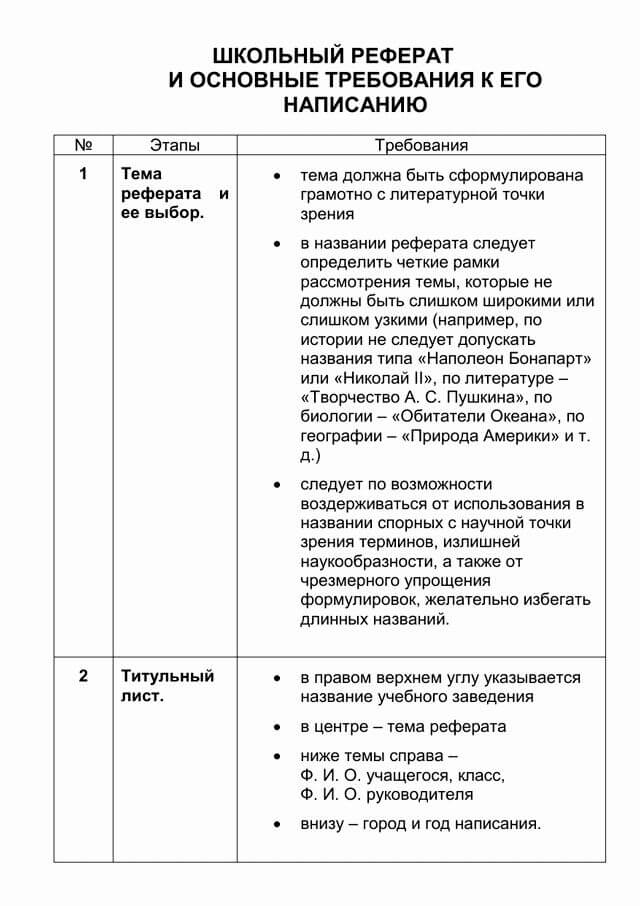
Each indentation and font size has its own instructions from the Ministry of Education, but the problem is that educational institutions have the right to make their own requirements for the title page. Moreover, each department can make its own amendments to the design first sheet. The whole transformation process ends with teachers, who often do not pay attention to "requirements from above" and put forward their own "tested" schemes.

If disagreements arise, then it will not be possible to prove anything to the respected professor. Therefore, when making a title page, there is a proven way - to ask the teacher for it. This way you can avoid unnecessary worries and save time on polishing the title page. But still, often the teacher is asked to issue the work “correctly”, that is, according to state standards.
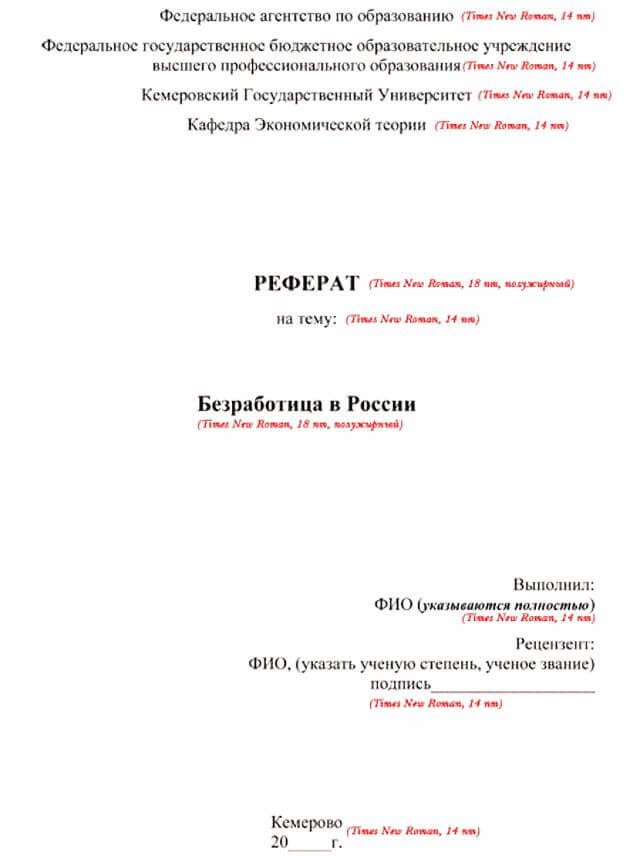
How to properly format the title page of an abstract according to state standards?
Upper block
The name of the educational institution is written at the top, it is worth paying attention that it is written in full. For example: "Vologda state academy named after N.V. Vereshchagin. The entire name can be written in CAPITAL LETTERS (holding Caps Lock). The name is written in full! With all the "Ministry of Education ..." and "Higher educational institution …».
The text should be bold, with center alignment set. To save space, you can make line spacing equal to one. The font size for the entire title page is chosen one - 14 point.
The top block should have a 2 cm deviation from the top of the sheet. The same indent should be for the bottom block from the bottom of the sheet. For the left side, the indentation has already been given above, and for right side it is better to make it one and a half centimeters. Speaking about the fields, it should be noted that it is this indicator that changes most often, therefore it is better to ask the teacher about them.
central block
It goes immediately below the top block, and you need to indent two lines (Enter twice). The central block consists of four or five lines or lines, each with its own information:
- first line- the name of the faculty, but it is often written in the upper right corner of the title page, you should check this line with the teacher;
- second line- the name of the department, written in ordinary letters (14 size), the first word "Department" with capital letter(Department of Anatomy and Histology);
- third line – capital letters(Holding Caps Lock) “SUMMARY” is written, this is the main word in the entire title page, so you can make it in 16 point font. You also need to make a gap of one line between this line and the previous one;
- fourth line- the name of the discipline. For example: “By discipline: Anatomy of farm animals”, while the first letters in the line and the title are written in capitals;
- fifth line- the title of the work, first with a capital letter write "On the topic:", and then with a capital letter the name of the work. Write it in full, even if it is large, the title of the work can come out in two lines.
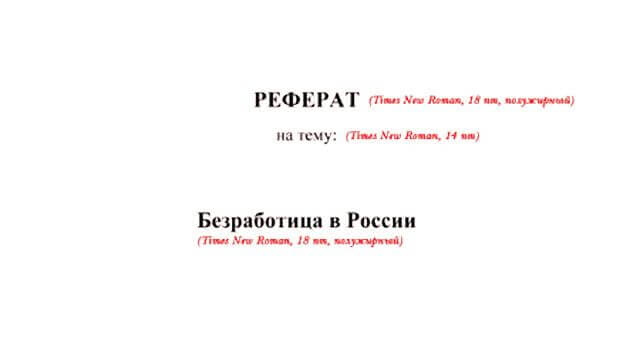
right block
We will divide it into two parts: for the teacher and the student.
Your part, as the author of the work, will consist of 6 lines:
- Completed:
- 1st year student
- day department
- Groups №XXXL
- Ivanov Ivan Ivanovich
- Signature:
The teacher part consists of 7 lines:
- Scientific director
- Professor / Associate Professor / Senior Lecturer (ask the teacher for his status)
- Departments of Anatomy and Histology
- Petrov Petr Petrovich
- Grade:
- Date of:
- Signature:
All words are written in 14 point, regular font.
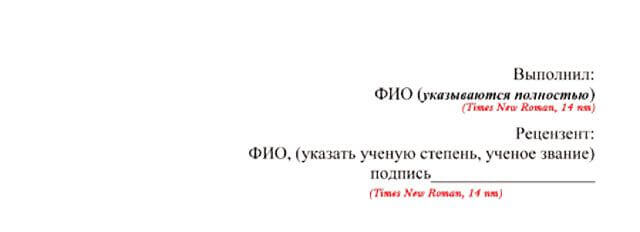
bottom block
The easiest block to design. Make some indents so that the two lines of the bottom block fit at the very bottom. Usually you need to skip 7-8 lines. First, write the name of the city, and below - the year of writing the work.
How to arrange the title page of the report at the institute and school?
There are no differences in the design of the abstract and the report. Only instead of the word "Abstract" write "Report". Confusion can cause a report at school, but you can draw it up according to the same rules as an abstract. Fonts and indents in school report similar to a university essay. In a school report, you can increase the font of the topic name, frames and underlines are also allowed. If the work is creative (on the topic of culture and art), then you can choose more original fonts. In the upper block, indicate the name of the school (in full). In the middle block, skip the name of the department and discipline. The right and bottom blocks are identical to the student's abstract.

